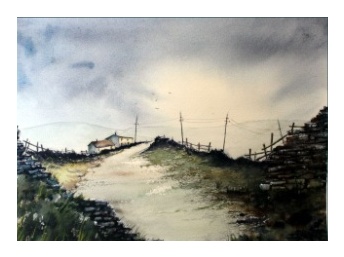|
If you can afford only one brush, buy a No8 round red sable watercolour brush. Otherwise buy the best synthetic or synthetic-blend brush you can find. Adding a round
No4 and a 1" flat would come in handy for detail work and large washes. Most manufacturers have starter sets that contain very usable equivalents.
Select a set of cake or moist pan watercolours if you prefer them. Most have a good selection of basic colours you'll need for transparent watercolour painting. Do not use the white paint that is included in most cake or tube colour sets. It's opaque. It's use would change your watercolour paintings into gouache paintings. Gouache, or opaque watercolour is a distinctly different category and approach to painting.
If you prefer tubes pre-packaged tube sets will also give you a good starter selection of colours for watercolour painting. Start by using brand name "academic" or "student" grade watercolours until you can commit your resources to buying "artist" grade watercolour supplies.
Use any watercolour pad, block, or loose paper with a weight of 140lb or higher. The heavier the paper, the less likely you'll have to deal with the warping
of the damp paper while painting. Try different surface textures to find your favourite.
Cake and Pan watercolour sets usually have built-in fold out palettes that are useable in varying degrees depending on their size and orientation.
For your tube watercolours you can use a flat white dinner plate or buy some inexpensive 6 or more welled plastic palettes like the ones you used in grade school for your tempera paints.
A covered plastic palette makes for the least waste and most convenience if you are using tube watercolours. If you are getting serious, buy one.
Find a glass, or jar, or small bucket to hold fresh, clean water. Use two if possible. One for rinsing your brush between colours, and one for clean water for painting.
Tap water is usually fine. Hard water decreases paint solubility and flow. Overly softened water acts as a wetting agent and increase paint solubility and flow. If you're concerned, use bottled water.
A few more odds 'n' ends will round out your kit. A pencil, a kneaded eraser, some tissues, and an old towel or paper towels, and a couple of large metal clips for holding your watercolour paper to a board.
That's all you need to start your adventures in watercolour painting.
Come to think of it, that's really all the materials you need to create a world-class masterpiece of art.
If you find yourself getting good at watercolour painting, immediately upgrade your paints to artist-grade and your paper to archival quality. Then proceed to have fun making what the world has never seen.
How to Be a Green Artist
Artists can also use Earth-friendly products that promote healthy uses of the planet’s resources.
Here are a couple of ways for artists to go green while saving money in the process.
Create Your Own Paper
Creating art paper from old art paper is a smart way to recycle and create paper that is perfect for the artist’s needs. Here is a recipe for creating watercolour papers at home. Using this recipe, the artist can also make pastel paper by adding silica for tooth.
Reuse Dried Watercolour Tubes
There’s no need for an artist to let a dried watercolour tube end up in the garbage. It can be recycled into watercolour pans.
1.Lay the tube flat on the work surface.
2.Use a utility knife to cut a line down the centre of the aluminium and across diagonally.
3.Pry the aluminium back with the tip of the utility knife.
4.Remove the dried watercolour paint in one piece.
5.Use the dried watercolour as a watercolour pan. Wet a brush and dab it onto the watercolour to get pigment on the brush.
| 






